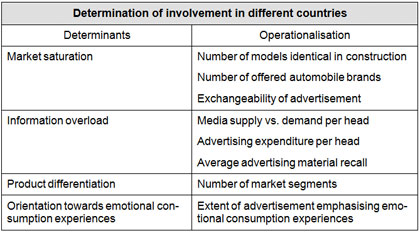1.2 International analysis of the initial situation
Account planning bases upon the analysis of the initial situation, as it is not possible to evaluate which target situation should be strived for with-out knowing the actual situation (Sander 1993, p270).
In order to analyse the initial situation, many legal, technical and social criteria are suggested (Berndt et al. 2003, p205; Clifton 1997, p145; Mooij 1991, p375 f.). However, with regard to the target of international positioning, these criteria are less relevant, as they indicate at best whether an international advertising campaign is realisable but do not provide an indication how it should be designed in an ideal way.
In terms of a behavioural-science definition of account planning, rather psychological advertising objectives are relevant. Psychological advertising objectives, such as brand awareness and image are operational objectives in advertising design, because they refer to the mental process preceding the buying behaviour and possibly systematically being influenced by advertising campaigns. However, this is different with economic advertising objectives such as turnover and market share. Whether these are attained, depends on many parameters that cannot be assigned to advertising, such as cyclical fluctuations or price cuts. This problem of accountability is less subject to psychological advertising objectives. In contrast, these refer to the manipulation of attitudes which lie “behind” the behaviour and whose formation is explained through modern step models of advertising impact. The pivotal determinant of attitude is the involvement of the target group (Kroeber-Riel, Esch 2000, p32 ff.).
The dedication with which someone turns to an object or a circumstance is defined as involvement. In case of low involvement, the consumer is passive and indifferent to the offer. The involvement has thereby two components. We differ between cognitive and emotional involvement. If the cognitive involvement is high, consumers actively take in information and assimilate it with high complexity. This applies to products which have strong differences compared to competing offers, because the technical or financial aspect of the perceived purchase risk. However, in case of a high emotional involvement, the consumer is emotionally so fascinated by the product that he turns to it with a strong dedication without reflecting the objective product features. (Kroeber-Riel, Weinberg 1996, p360 ff.).
For international account planning it is decisive that the involvement of consumers from different countries may vary and thus influence the appropriate advertising objectives (see chapter 2.3.3). The variations primarily result from different market and communication conditions in Europe:
- saturated markets,
- high product differentiation,
- Orientation towards emotional consumption experiences of consumers,
- Information overload for consumers.
The automotive markets in Europe are saturated. The sales stagnate. There is an excess supply of comparable, fully developed, high-quality products, such as minivans like the Volkswagen Sharan, Ford Galaxy and Seat Alhambra, which are identical in construction apart from brand specific design features. In view of the exchangeability of objective product features, the consumers barely show interest in the corresponding information of the advertisement. This leads to low cognitive involvement.
As the basic needs in industrial countries are largely satisfied, self-realisation and sensual stimulation become more important. Consumption, too, becomes a possibility of emotional experience. Consumers evaluate automobiles according to the extent they contribute to their lifestyle. (Naisbitt, Arburdene 1990, p156). This trend causes a high emotional involvement.
In line with the increased hedonism and orientation towards emotional consumption experiences of consumers, a multiplication of the value system can be observed. Correspondingly, the reasons for consumption strongly vary (Maddox 1996, p290). The automotive manufacturers respond to this development with extreme product differentiation. While in the 60ies basically 3 model types were offered (saloon, roadster, spider) there are nowadays twenty segments. Moreover, some models, which are identical in construction, can only be distinguished by emotional attributes (Wildemann 2003, p18). This is accompanied by a high emotional involvement.
The automotive industry annually affords increasing amounts in order to inform about its variety of models. This results in an enormous information overload which constrains advertisement. It becomes more and more difficult to find an attentive ear because the audience of advertisement establishes barriers in perception in order to seal off from information overload. This manifests itself in a low cognitive and emotional involvement.

Table 2: Advertising planning data in order to define psychological advertising objectives.
With regard to its potential to standardise, the analysis of the initial situation is to be rated as repetitive task, because it accrues with the planning of each international campaign. Moreover, the information is internationally ascertainable. In case of lacking media data, it can be switched to auxiliary variables. Besides, the individual processes of the analysis are observable. Altogether, this task of international account planning can be considered to have the potential to standardise. In view of the market knowledge by national sales companies, the analysis of the initial situation should be delegated to them.
Further Chapters
- Standardised international account planning
- International analysis of the initial situation
- International advertising strategy
- International advertising budget planning
- International planning of advertising design
- International media planning
- International advertising control
- The implementation of international
